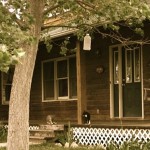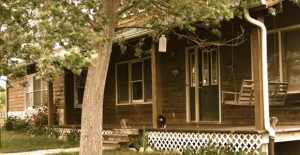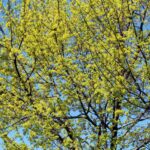Dreher posts a wonderful reminiscence on his home, on place, and on the ravages of time.
I thought about this memory this weekend, visiting Ruthie and my family. Ruthie and Mike bought part of what was once the orchard from our distant cousins, and built their house there. The rest of the land that had once been Lois and Hilda’s was sold to strangers. The cabin has long been gone; a nice big brick house belonging to someone I don’t know is now where the cabin was. True to Hilda’s palm-reading prophecy, I traveled far in my life. I have now spent well over half my life living away from there. Yet that is home for me, because that is where my family is, and the landscape of my childhood. Now, though, my parents are getting up in years, and my younger sister, at age 40, is battling a disease that may take her life. I hadn’t realized until this crisis with Ruthie how much I had counted on the continuity of her remaining there, even after our parents pass away, to anchor that place as the center of my imaginative universe. She, who has always loved the land and her place there far more than I, and she, whom I could count on to always be faithful to it, however unfaithful I was, sits in her armchair in what was once the orchard, coughing and straining for breath. We hope and we pray for healing, but now the way I thought the world would be may not be the way the world is, or will become. And I am having a hard time coming to terms with that, as both an emotional and a philosophical matter (i.e., trying to understand how to relate to where I come from now that the permanence I assumed would always be there is threatened).
Nothing lasts. It’s one thing to grasp that intellectually, but to live through the impermanence of things is something else.
This reminds me of Richard Quinney’s haunting memoir Of Time and Place, which I reviewed a while back for The University Bookman:
Finally, crucially, Quinney recounts his efforts in retirement to preserve the farm. Most tellingly, there are no photographs of future generations of Quinney farmers. No one younger than Quinney appears at all. In fact, all the evidence suggests that Quinney is the last of the line. The farm will not be farmed again, at least not by a Quinney. In place of that living thread, Quinney arrives at the photographic metaphor of a still life, the metaphor at the heart of Of Time and Place. “My self-imposed project is to photograph the artifacts, to make a record of the things that remain of the life that once was here. . . . These old and inanimate things now have an afterlife as they rest among the ruins.” Quinney peppers the last pages of his memoir with these still lifes—photographs of old artifacts, no longer used, piled against walls, in tool sheds, on shelves. The impression is one of an uncovered Egyptian tomb, all worldly possessions waiting patiently to be used again, in the afterlife. Quinney confirms the impression: “I am haunted by the mysteries of time and place. Fortunate I am to have my camera to see into the afterlife of things.”
Quinney’s narrative is pungent with the invitation to trespass. It is profoundly unsettling, as if Quinney has compensated for a failure of issue with a public embalming. The reader begins to sense something unseemly about his presence. We know we should not be here. But Quinney beckons us in, tempting us to unearth the dead, a desire both vaguely grotesque yet also strangely compelling for an America cut adrift. In this, Of Time and Place teaches its most important lesson unwittingly—that America is all too ready to settle for a “still life” of its past; unearthed, framed, and stuck on the wall (or in the scrapbook), awaiting the afterlife. In doing so we trespass against the past, ending up haunted, as Quinney is, forever hearing sounds that come “from another land and another time.” In the end, most will succumb to the kitschy traditionalism of suburbs with streets named Poplar Lane and “distressed” furniture purchased as talismans to ward off the ghosts.
The need for an alternative American myth—one that is situated in a usable past of a particular time and place—is real and pressing. But housing that past in a museum is a false remedy, partaking of the same derailments of therapeutic management that grip the man with a pathological need for endless fresh starts. The human need for belonging is fundamentally outside our control; it is something achieved only in submission. The most basic lesson may be that a usable past requires a usable present. When I was young, our family frequented the cemetery in which my ancestors were buried. We picnicked there and the children played hide-andseek among the gravestones. It is an apt and pregnant image. A living heritage picnics on the graves of its ancestors. That is no trespass, but is instead an act of loving continuity with the past. And the successful inhabitation of a place requires transmitting the intimacy of that fidelity, not in “still life” to strangers, but across generations within the ties that bind. Those ties that bind—buttressed by a mutual effort for survival under conditions of hardship and scarcity—form the only existential context within which the ghosts rest easy.





2 comments
Junker
Time hurries on, and the leaves that are green turn to brown…….
http://www.youtube.com/watch?v=y1Bl4BnU_NI
Russell Arben Fox
I remember that review, Caleb, and the quaint, concrete, simple, yet haunting image you provided of “an act of loving continuity with the past.” Thanks for the reminder.
Comments are closed.